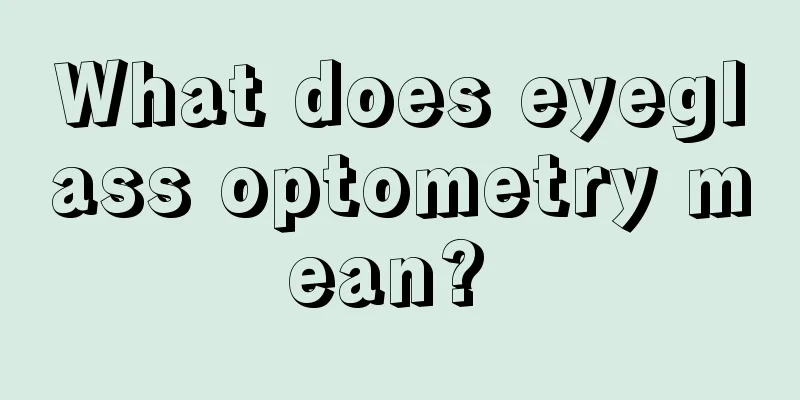What does eyeglass optometry mean?

|
It can be said that everyone will suffer from myopia, especially some teenagers. Almost nine out of ten wear glasses, so preventing myopia has obviously become the first thing children should do. Of course, with the continuous improvement of science and technology, myopia can also be treated, such as laser, but wearing glasses is still a common method. So before buying myopia glasses, do you know what eyeglass optometry means? Optometry is the examination of the convergence of light after it enters the eyeball. It uses the emmetropia state as the standard and measures the degree of difference in convergence between the examined eye and the emmetropia eye. Since many people will have to wear glasses almost throughout their lives, optometry is currently one of the most basic, most commonly used but important tasks for optometry workers. Therefore, as far as the term optometry is concerned, both ophthalmologists and ordinary people are very familiar with it in social life. Optometry method There are many methods of optometry. Based on whether the eyeball is allowed to adjust and remain still, it can be divided into dilated pupil optometry and small pupil optometry. According to the optometry method, it can be divided into heterosexual optometry and subjective optometry. As far as optometry equipment is concerned, in addition to conventional equipment such as optometry lens boxes and retinoscopes, there are also computer optometrists and comprehensive optometrists. Computer ophthalmometers were once over-promoted, but through a large amount of data analysis, it is found that although computer ophthalmometers are the result of high technology, they can only make preliminary screening of refractive status, and their results cannot be used as the standard for optometry. The comprehensive ophthalmometer integrates multiple inspection functions. Since its birth in the early 20th century, it has been continuously improved and developed. It can not only check the spherical refractive power, but also correctly detect the astigmatism degree and astigmatism axis. In addition, it can also make correct judgments on eye position, adjustment status and binocular single vision function. Proficiently mastering and using the comprehensive ophthalmometer is a key measure to improve the level of optometry. The level of optometry in China varies widely. If the score is given on a 5-point scale, 1 point is: subjective insertion method; 2 points: computer ophthalmometer + subjective insertion method; 3 points: computer ophthalmometer + retinoscopy + subjective insertion method; 4 points: 3 points + binocular accommodation balance; 5 points: 4 points + eye position examination + binocular single vision function + accommodation status + refractive status + convergence function, etc., to make a comprehensive judgment and give an optometry prescription. Among them, optometry with 1 to 3 points can be called routine optometry or primary optometry; and optometry with 4 to 5 points can be called medical optometry. Medical optometry must use a comprehensive ophthalmometer. So why do we need to use a comprehensive ophthalmometer? As we all know, when a myopic patient wears a -3.00D corrective lens, the corrected visual acuity can reach 1.0. At this time, the five corrective lenses of -3.25D, -3.50D, -3.75D and -4.00D can all make the corrected visual acuity reach 1.0. If you use conventional optometry, you can only choose one of these five corrective lenses as your optometry prescription, which is somewhat arbitrary. This is not the case in medical optometry. It depends on the test results of the patient's eye position, accommodation, binocular single vision and convergence function. Only one fixed lens can be selected, and even -2.75D can be selected as the final optometry prescription. From this point of view, medical optometry and conventional optometry have different meanings and contents, as shown in Table 1. From a medical point of view, the purpose of wearing corrective glasses is not only to enable patients to see objects clearly, but also to make them comfortable wearing the glasses, and to treat certain possible eye diseases, such as visual fatigue, latent esotropia or exotropia, and medical optometry is the basis of this. |
<<: What is the easiest way to remove contact lenses?
>>: How often should you change your contact lens case?
Recommend
What is the best drink to clear the lungs?
If you have lung heat in your life, it will affec...
How is endometrial cancer staged? Generally divided into four stages
The uterus is an important organ for women. If th...
What foods are good for liver protection?
Liver function is easily affected by diet and oth...
What types of dentures are there
Once there is a problem with teeth, it will bring...
What are the types of hemorrhoids?
As people's living standards improve, the cha...
What to eat to relieve the spiciness after eating chili peppers
There are huge differences in the attitudes towar...
How to massage patients with ovarian cancer
Massage is one of the oldest physical therapies f...
The probability of inheriting kidney cancer from generation to generation
For kidney cancer, the growing cancer cells will ...
Emotional self-control
People's emotions are quite difficult to cont...
How to quickly stop itching from mosquito bites
Mosquitoes are common creatures living all over t...
Growing up with children
The healthy growth of children is what parents ca...
What to do if bitten by a grasshopper
The so-called grasshopper is what we often call g...
I ate a rotten banana and had diarrhea
Bananas are a common fruit in our lives. Because ...
Thyroid cancer is one of the cancers with the highest cure rate
Thyroid cancer is one of the more common malignan...
Causes and symptoms of traumatic macular hole
Traumatic macular holes can be said to be the ear...









